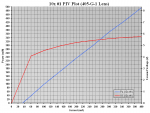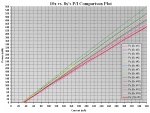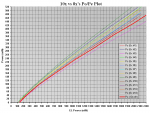daguin
0
- Joined
- Mar 29, 2008
- Messages
- 15,989
- Points
- 113
I got the 10X sled from Freqjn yesterday. I got the chance to look at it today. Since we are comparing this LG 10X to the LG 8X, I decided to strip them side-by-side so everyone can see.
The differences between the Pioneer 8X and the Pioneer 12X in both the sled and the diode are very small. About the only real physical difference between them is the missing beam circlerizer in the 12X sled.
There are significant differences between the LG 8X and the LG 10X
In the pictures the 10X is on your left (the monitor's right)
Here is the back of the sleds. You can see the first of the differences in the metal "covers." The metal of the 10X is MUCH heavier and covers more of the sled than the metal on the 8X. The 10X sled is also a bit smaller

Here is the front of the sleds. The next major difference is more obvious here. The 10X sled is made of a composite/plastic material instead of the metal alloy we are used to. Pyrotechnic enthusiasts are crying into their beer about now.

Here's a shot of the ribbon assembly. You can also see the differences between the metal covers in this shot.

Here's with the ribbon assemblies removed. The 10X is, optically, more "simple" than the 8X. There are fewer optical components. Also there are NO beam splitter cubes in the 10X

Here I have circled the violet and the red diodes for you. Another major difference becomes obvious in this one. The violet diode is on the other side of the sled. Also, the 8X heat sink is "buried" in and completely surrounded by the metal of the sled. Whereas the 10X heat sink is just "glued" onto the outside of the plastic sled. Finally, the red diode's heat sink is covered by copper in the 8X and "bare" in the 10X

Here are the diodes, in their heat sinks removed from the sleds. The violet diodes are the ones to the outside. The red diodes are the ones to the inside. The heat sinks of the violets are obviously different. The heat sinks of the red diodes are also different. The 8X's heat sink is smaller and does not surround the diode like the 10X red's heat sink

Both of the red diodes appear to be the same. Just their heat sinks look different.
There are some differences between the violet diodes. First, all three pins in the 8X are soldered to the ribbon cable. In the 10X the case pin is not soldered to the cable. The 10X also has a "board" rather than just a ribbon. The pins on the 10 are significantly longer than the pins on the 8X (YEA!)
Finally, the markings on the violet diodes are different. There are no markings on the can of either diode. The square "bar code" is the same size and in the same position on the backs of the diodes. The bar codes are different. We have seen that before in the same diodes. Probably denoting "batch" differences. One consistent difference is the little "x" above the bar code on the 10X. You can see it here in Freqjn's macro. This 10X diode has it as well. I have never seen that little "x" on an 8X diode.

That's as far as I have gotten for now. Those of you who have been patiently waiting for something from me already know that I have the flu. I will wait to do the IP/OP graph after I have recovered a bit
Peace,
dave
The differences between the Pioneer 8X and the Pioneer 12X in both the sled and the diode are very small. About the only real physical difference between them is the missing beam circlerizer in the 12X sled.
There are significant differences between the LG 8X and the LG 10X
In the pictures the 10X is on your left (the monitor's right)
Here is the back of the sleds. You can see the first of the differences in the metal "covers." The metal of the 10X is MUCH heavier and covers more of the sled than the metal on the 8X. The 10X sled is also a bit smaller

Here is the front of the sleds. The next major difference is more obvious here. The 10X sled is made of a composite/plastic material instead of the metal alloy we are used to. Pyrotechnic enthusiasts are crying into their beer about now.

Here's a shot of the ribbon assembly. You can also see the differences between the metal covers in this shot.

Here's with the ribbon assemblies removed. The 10X is, optically, more "simple" than the 8X. There are fewer optical components. Also there are NO beam splitter cubes in the 10X

Here I have circled the violet and the red diodes for you. Another major difference becomes obvious in this one. The violet diode is on the other side of the sled. Also, the 8X heat sink is "buried" in and completely surrounded by the metal of the sled. Whereas the 10X heat sink is just "glued" onto the outside of the plastic sled. Finally, the red diode's heat sink is covered by copper in the 8X and "bare" in the 10X

Here are the diodes, in their heat sinks removed from the sleds. The violet diodes are the ones to the outside. The red diodes are the ones to the inside. The heat sinks of the violets are obviously different. The heat sinks of the red diodes are also different. The 8X's heat sink is smaller and does not surround the diode like the 10X red's heat sink

Both of the red diodes appear to be the same. Just their heat sinks look different.
There are some differences between the violet diodes. First, all three pins in the 8X are soldered to the ribbon cable. In the 10X the case pin is not soldered to the cable. The 10X also has a "board" rather than just a ribbon. The pins on the 10 are significantly longer than the pins on the 8X (YEA!)
Finally, the markings on the violet diodes are different. There are no markings on the can of either diode. The square "bar code" is the same size and in the same position on the backs of the diodes. The bar codes are different. We have seen that before in the same diodes. Probably denoting "batch" differences. One consistent difference is the little "x" above the bar code on the 10X. You can see it here in Freqjn's macro. This 10X diode has it as well. I have never seen that little "x" on an 8X diode.

That's as far as I have gotten for now. Those of you who have been patiently waiting for something from me already know that I have the flu. I will wait to do the IP/OP graph after I have recovered a bit
Peace,
dave







